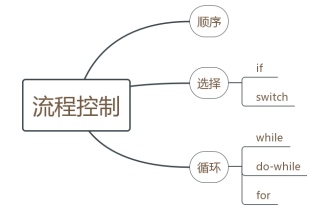Java三大流程控制语句:顺序、选择、循环。

if结构、if-else结构、多重if、嵌套if。
1 public class Test { 2 public static void main(String[] args){ 3 int a=1; 4 int b=1; 5 if (a==b) 6 a++; //不加大括号,只能有一句语句 7 else 8 a--; 9 10 11 if(a==b){ 12 a++; 13 b++; 14 }else{ 15 a--; 16 } 17 18 19 if(a<10) //多重if结构 20 a++; 21 else if(a<20) 22 a--; 23 else if(a<30) 24 b--; 25 else 26 a*=10; 27 28 29 if(a==b){ //嵌套if结构,将整个if块插入另一个if块中 30 if(a>0) 31 if(a==1) 32 a++; 33 }else{ 34 b+=10; 35 } 36 37 } 38 }
if结构:判断条件是布尔类型,是一个范围。
switch结构:判断条件是常量值。
1 public class Test { 2 public static void main(String[] args){ 3 int x=4; 4 switch (x){ 5 case 1:System.out.println(x); 6 case 2:System.out.println(x); 7 case 3:System.out.println(x); 8 case 4:System.out.println(x); //运行结果444 9 case 5:System.out.println(x); 10 default:System.out.println(x); 11 } 12 System.out.println("-----------------------------------------------"); 13 switch (x){ 14 case 1:System.out.println(x); 15 break; 16 case 2:System.out.println(x); 17 break; 18 case 3:System.out.println(x); 19 break; 20 case 4:System.out.println(x); //运行结果4 21 break; 22 case 5:System.out.println(x); 23 break; 24 default:System.out.println(x); 25 } 26 } 27 }
switch用于多分支选择,代码中的x可以是int 型或能自动转换为int型的变量、final定义的下述类型常量或数值(包括整数或字符)、整数表达式(含有变量或常量均可),包括:byte、short、char、int以及它们对应的包装类(Java7后支持String类型)。
为什么呢?因为byte、short、char类型的值能被隐式地转换为int型,long、float、double类型不能隐式地转换为int型,因此不能作为switch或case的常量参数或常量表达式中,除非对其强转为int型。
如:switch(1) switch(a)[假设int a=1; short a=1; final int a=1;...] switch('a') switch(2+1) switch(a+2)[假设a已被定义]
case后对应其常量值、整数表达式(不能出现变量,即使是final型也不可以,只能是整数数字)、final型的常量、字符串
如:case 1: case 'a': case 1+1: case z: [假设final int z=1;] case "hello":
switch对字符串的支持,也是因为int型值的匹配。对case后的String对象调用hashCode()方法,会得到一个int型的hash值,用此hash值唯一标识这个case。匹配时首先调用这个字符串的hashCode()函数,获取到一个hash值,用这个hash值去匹配所有case,若没有匹配到,说明不存在;若匹配成功,接下来调用字符串的String.equals()方法进行匹配。因此,String变量、case子句的字符串都不要为null。
如果不想要匹配后的case后的语句都输出,不要忘记在每句后加break;
1 public class Test { 2 public static void main(String[] args){ 3 int a=1; 4 int i=0; 5 while(a==1){ 6 a++; 7 System.out.println(a); //2 8 } 9 do{ 10 a++; 11 }while(a==1); 12 System.out.println(a); //3 13 for( i=0;i<3;i++){ 14 for(int j=0;j<=i;j++){ 15 System.out.println(j); //0 01 012 16 } 17 } 18 System.out.println(i); //3 19 } 20 }
可互相嵌套循环。for循环三个表达式均可省略,注意for循环表达式的执行顺序,表达式2,中间体,表达式3,再表达式2比较,...
对于break、continue、return:
break是跳出当层循环;continue是跳出当次循环,此层循环中continue后面的语句不再执行,回到循环起始处继续执行;return是使程序控制返回到调用该方法的地方,当执行main方法时,return可使程序执行返回到Java运行系统。